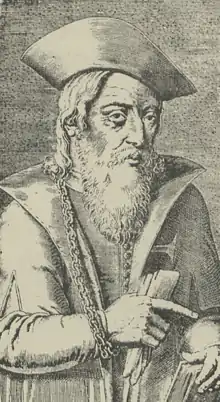Francisco de Sá de Miranda
Francisco de Sá de Miranda (28 August 1481 – 17 May 1558; Portuguese pronunciation: [fɾɐ̃ˈsiʃku dɨ ˈsa dɨ miˈɾɐ̃ðɐ]) was a Portuguese poet of the Renaissance.
Francisco de Sá de Miranda | |
|---|---|
 | |
| Born | 28 August 1481 |
| Died | 17 May 1558 (aged 76) |
| Nationality | Portuguese |
| Occupation | Poet |
Life
Sá de Miranda was born in Coimbra, the son of a canon Gonçalo Mendes de Sá[1] belonging to the ancient and noble family of Sá and Inês de Melo.[1] His brother, Mem de Sá, was the third governor of the Portuguese colony of Brazil.
Sá de Miranda passed his early years by the banks of the river Mondego, considered a source of inspiration to many other poets. He made his first studies of Greek, Latin and philosophy in the college of the Santa Cruz Monastery, and in 1505 went to University of Lisbon[1] (the University of Coimbra had moved to Lisbon in 1380) to study law, beginning at the same time to attend the Portuguese court and write poems in the mediaeval style still dominant in Portugal.
He travelled to Italy in 1521, where he was able to make contact with many writers and artists of the Renaissance, including Vittoria Colonna[1] (who was his relative), Pietro Bembo,[1] Sannazzaro and Ariosto. On his way home, in 1526, he visited Spain, meeting classical writers Juan Boscan and Garcilaso de la Vega.
Back in Portugal in 1526 or 1527, he was again received in the court, where he became a friend to King John III and other nobles. Four years after his return he decided to move to the Minho province, in the North of the country, where he purchased land. Around 1530 he married[1] Briolanja de Azevedo,[2] a lady of noble birth.
In 1552 he moved to the Quinta da Tapada, near Amares, where he died in 1558, aged 76.[3]
Work
Like many Portuguese writers of his time, Sá de Miranda often wrote in Castilian[1] apart from Portuguese. His early work is all in the form of the typical 15th-century Portuguese poetry (the vilancete, the cantiga, the esparsa and the trova). Influenced by his travels in Italy and Spain, Sá de Miranda introduced a new aesthetics in Portugal.[4] He introduced the sonnet,[1] the elegy, the eclogue, the ottava rima[2] and other classical poetic forms, adapting the Portuguese language to the Italian hendecasyllable verse. These forms, especially sonnet and ottava rima were later used by many Portuguese poets including Luís Vaz de Camões.[5]
Apart from poems, Sá de Miranda wrote two theatrical comedies following classical forms: Estrangeiros (staged in Coimbra in 1528 and published in 1559) and Vilhalpandos (written around 1530 and published in 1560). His tragedy Cleópatra[6] has only survived in fragments.
He also left several letters in verse, addressed to people like King John III and his brother Mem de Sá.
References
- "Francisco de Sa de Miranda | Portuguese author". Encyclopædia Britannica. Retrieved 29 September 2016.
- Prestage, Edgar (1911). . In Chisholm, Hugh (ed.). Encyclopædia Britannica. 23 (11th ed.). Cambridge University Press. pp. 990–992.
- Sá de Miranda – Biografia e obras.
- Miranda, Francisco de Sá de.
- Luis de Camões at Sonnet central.
- Sá de Miranda st Projecto Vercial.
Bibliography
- Lusitania illustrata. Notices on the history, antiquities, literature &c, by John Adamson, Newcastle on Tyne 1842.
- Dreams of Waking: An Anthology of Iberian Lyric Poetry 1400-1700. Edited and Translated by Vincent Barletta, Mark L. Bajus, Cici Malik, The University of Chicago Press, Chicago 2013.